Building a dream data team is about much more than using the right data stack.
A few days ago, I gave a talk at dbt Coalesce about my experience building data dream teams, where I introduced a term that I call the “Modern Data Culture Stack”. It’s a topic I’ve been thinking about for years, but even so I was amazed at the response from the community.

For the past two years, there’s been a ton of noise about the modern data stack — the tools that have changed our way of working. As there should have been. The way we worked with data before the modern data stack was frankly as broken as broken could get. The data world’s first “delta” naturally needed to come from tooling that let data teams become more effective.
In the past four years, the modern data stack has made a ton of progress, and it’s gone mainstream thanks to the adoption of tools like Snowflake and dbt. Gaps in the modern data stack that were there as early last year (in areas like metadata management, data governance, and observability) are quickly being filled thanks to an advent of newer tools. With so much innovation in the space, I’m certain that in the next few years, all data teams will finally have a close to “perfect” data stack.
This makes me believe that, as we enter 2022, the conversation needs to shift from the need for better tooling to the next “delta” that will finally help us create dream data teams — the modern data culture stack. These are the best practices, values, and cultural rituals that will help us diverse humans of data (or the “purple people” as dbt coined) come together and collaborate effectively.
The challenges of building a dream data team, or why every data team needs a culture stack

I’ve been fighting with the promise and challenge of building great data teams for years. Data-driven teams have the potential to drive the greatest innovations in the coming years, like eliminating COVID, making self-driving cars a reality, or putting people on Mars. But we all know the daily struggles of actually working together as a data team…
- The frantic early morning calls to engineers when an important dashboard breaks
- The “for the love of god, just give me the data” request after weeks of waiting
- The gut-wrenching “This data doesn’t look right…” email from the boss
- The “Isn’t it obvious what ‘column_xxy81’ means?” or “Why is there a ‘file_2_final_final.csv’ and ‘file_3_final.csv’?!” questions on Slack
The reason it is so hard is because… well, data teams are one of the most diverse teams ever created. They’re built from analysts, engineers, analytics engineers, scientists, business users, product managers, and more — all with their own tooling preferences, skillsets, and limitations. The result is a mess of collaboration overhead and data chaos.
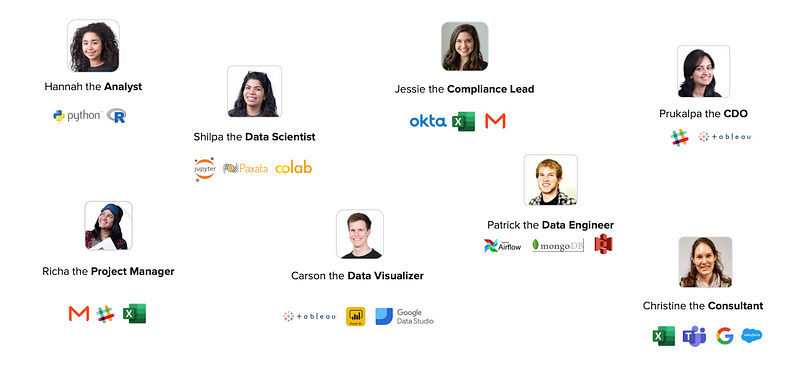
Atlan was born out these challenges. In 2016, we started the “Assembly Line Project” and started testing new ways to make our team more agile, reduce overhead, increase productivity, and build resilience. Two years later, we were six times more agile. I attribute this 6x agility to two key drivers — our tech stack (or the modern data stack), and our culture stack.
Building a dream data team isn’t just about using the right data stack. It’s about building a strong culture stack alongside it.
I’m going to break down how we created this culture stack and the best practices we found after lots of trial and error. That doesn’t mean that you should adopt these exact practices! Rather, they’re meant as a starting point to help your own team think about what’s right for you.
1. Lay the foundation for your culture stack: team values and charter
We started by bringing our entire data team together for an exercise modeled on Google’s Design Sprint.
We were all full of frustrations, but a couple of hours of complaining wouldn’t help us move forward (even though it would feel great!). So we used HMWs, or “How Might We” questions, to reframe our pain points as opportunities.
These became a dream wishlist for our data team — all of the things we wanted to do better in the future.
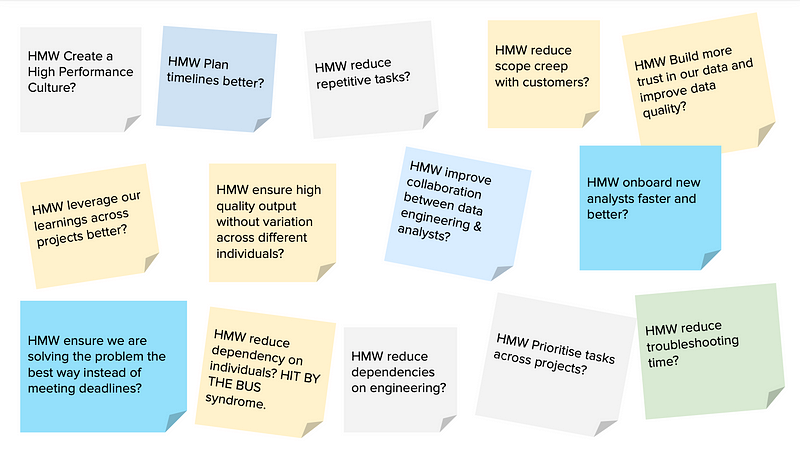
We then turned these goals into a Team Charter, or the key values that we wanted our data team to live by.
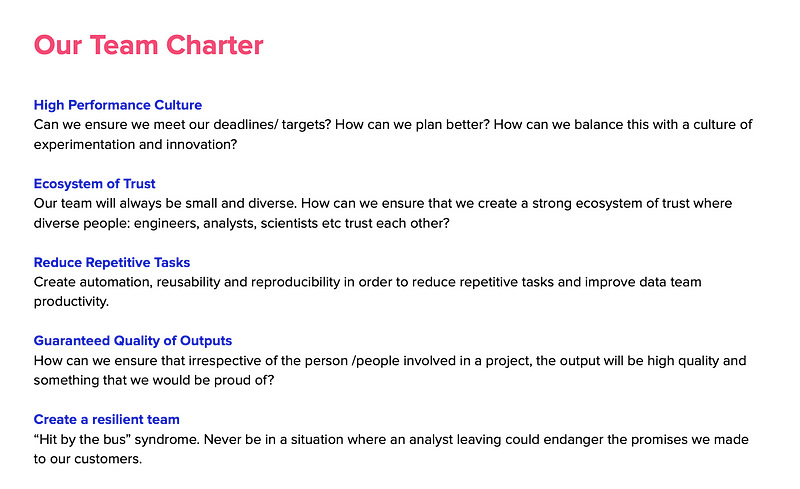
This charter doesn’t have to be perfect. (Clearly, ours wasn’t!) Instead of spending a ton of time crafting beautiful language, we made sure we were in agreement and kept moving forward.

2. Turn values into action with rituals that reinforce your values
Many people believe that culture “just happens”. It’s a mythical creature, and that’s just what it is…
I firmly disagree. Culture doesn’t just happen. You can work towards creating the culture you aspire to be by converting your values into something more tangible. We did this through “rituals”.
For example, we ended up solidifying our team’s charter into 4 key values: Agility, Trust, Collaboration, and Innovation. Then we worked to turn them into something real by mapping each value to specific rituals.
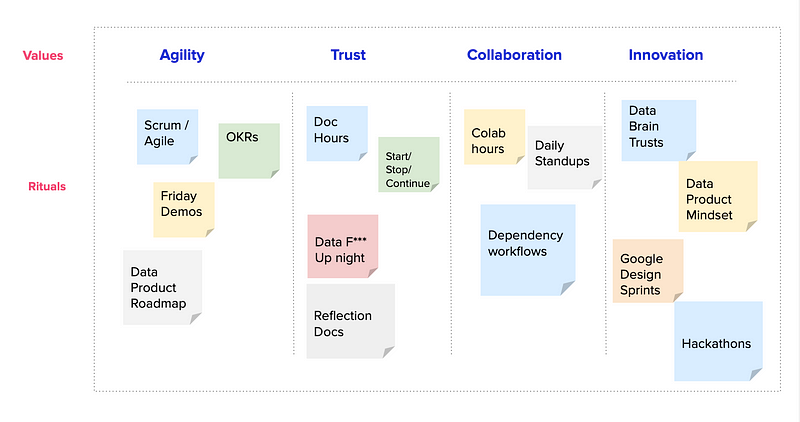
People had different ideas for rituals that might help, so we experimented with lots of new traditions and processes. Some worked great, and some were busts. But along the way, we learned a lot more about what it takes to help our team work together.
Together, these rituals became the culture stack that powered our data stack and human stack, and helped us become much happier and more agile.

3. Rolling out new rituals, bottom up rather than top down
I am a big believer in facilitating ways to build cultural rituals in a bottom-up, rather than top-down fashion. For this reason, I think the best way to frame a new ritual idea is an “experiment”. If the experiment works, then it becomes a ritual and a way your team works. If it doesn’t, you try something else.
Here are some best case practices for creating these new rituals:
- Start by agreeing on common principles and problems: Make sure you understand and agree on specific ideas that will run through your rituals. For example, one of our rituals was a quarterly Start, Stop, Continue exercise that threw light on the biggest problems that we cared about solving as a team.
- Get the team on the same page: Before we started experimenting with Agile and Scrum for the first time, our entire team read a copy of the book Scrum to understand the fundamentals behind the process. This was key. A new process like Scrum can seem like a massive overhead — and if enforced top down, there’s a chance it will just become another chore.
- Measure your progress: We’re data people after all! For us, weekly velocity measures and percentage completion goals helped motivate the team and keep us moving forward. A simple weekly Slack message that showed us how we were moving forward and improving made a world of difference.
- Build a culture of helpful questioning: No one will have the right answer, so it’s important to set aside egos and create open, friendly communication. For example, in our daily standups, we asked questions like “Why didn’t you achieve your goal for this week?” or “What kept you from completing this task?”. Creating a culture of radical candor and trust helped us continually learn how we could all do better in the future.

😍 Spotlights on our favorite rituals that helped us live our values
Data Brain Trusts to enable innovation
We were afraid that focusing on performance would make us less innovative, so we set up Brain Trusts. (This is an idea we shamelessly borrowed from Pixar and modified for our data team. Read this great view into how they do it.)
Most of the time, only one or two people work on a data project, but the entire team has collective knowledge and learnings from past projects that may be helpful.
In our Brain Trusts, we’d quickly leverage this knowledge for early-stage projects. We’d gather the team for 30 minutes, brief everyone on the project, and then go through a structured brainstorming process to help everyone create and contribute their innovative ideas.
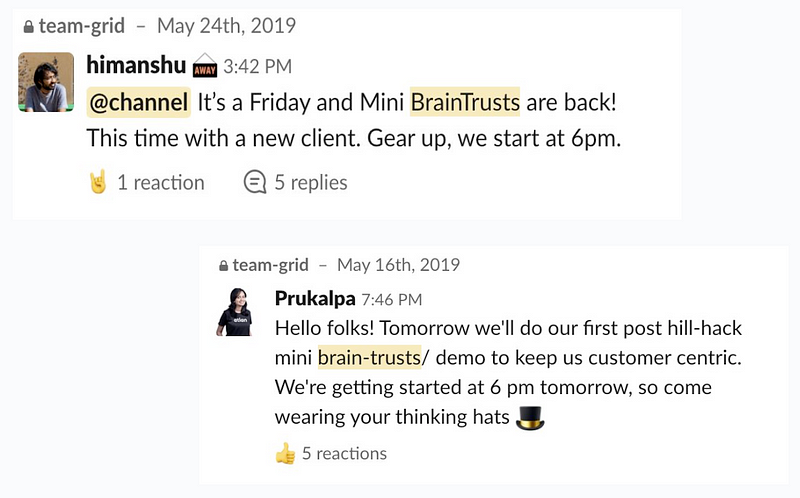
Data Cribbing Parties to enable trust and collaboration
Since data teams are so diverse, it can be hard for people to understand one another’s frustrations.
For example, a Head of Sales probably started out as a Sales Representative, but most Data Managers haven’t been Data Engineers, and most Data Engineers haven’t worked as Analysts. So when a dashboard breaks, it’s all too easy for an analyst to question, “Did the engineer even do his job?!” or for data teams to turn on one other.
These cribbing parties helped bring these frustrations out into the open. We blocked off an hour or two on a Friday night, sat together over dinner, and started complaining about what had gone wrong that week. Far from causing trouble, these helped us increase empathy and understanding for one another’s work.
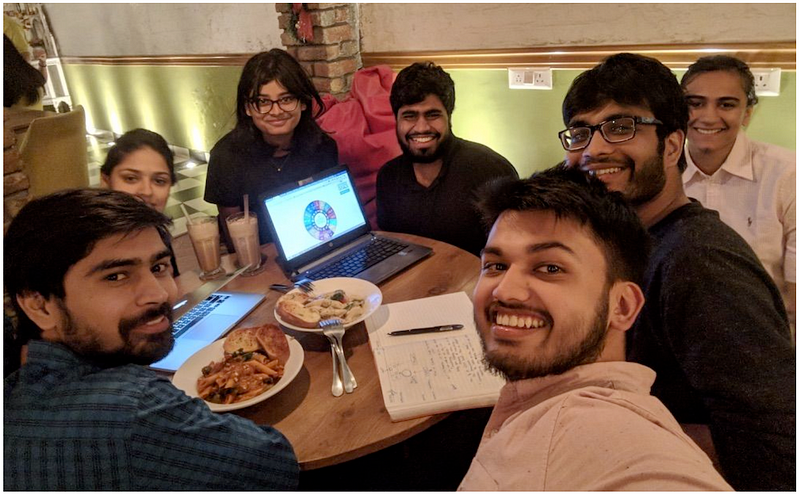
This is just an example of two rituals, but we invested in a ton of other rituals like daily standups, implementing Agile, weekly demos to encourage a shipping culture, and documentation hours.
I don’t want to end up writing a book here, so I’ll be doing a deep dive into our cultural rituals on my weekly newsletter.
Some final thoughts for data leaders
As you go into 2022, I would recommend strongly investing in your modern data culture stack just as much as your modern data stack. Just like your data stack, building a better culture isn’t easy or quick. It will take time, trust, and experimentation. There will be plenty of failures, but if you keep assessing and communicating, you’ll eventually end up with a dream data team.
If you’re serious about building out a data culture, I’d also recommend thinking about building a “Data Enablement” team. This can be modeled on a Sales Enablement team, which is responsible for driving cultural rituals, enablement, and program management for sales. These kinds of roles are very new, so you might want to look for existing folks in your team that are passionate about culture and team building. The kinds of personas that I think are great fits are analysts who have a flair for building community or program management or “chief of staff” type people.
As you enter 2022, ask yourself — is there anyone on your team whose full-time job it is to think about your data culture stack?
Header image: Robert Anasch on Unsplash